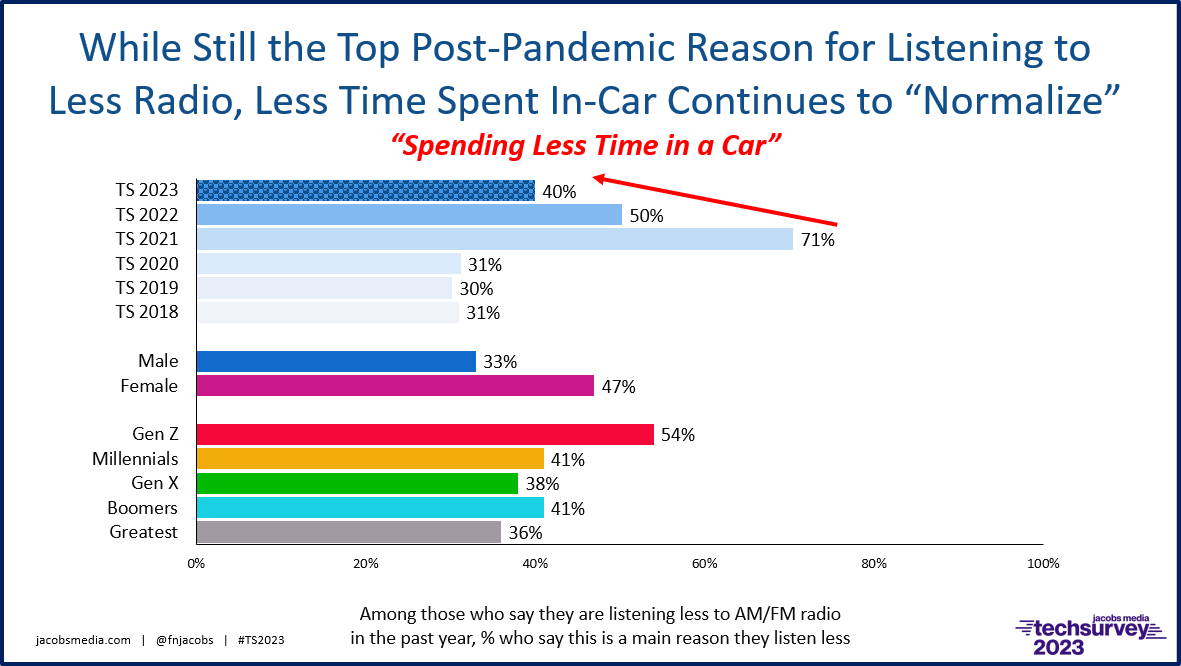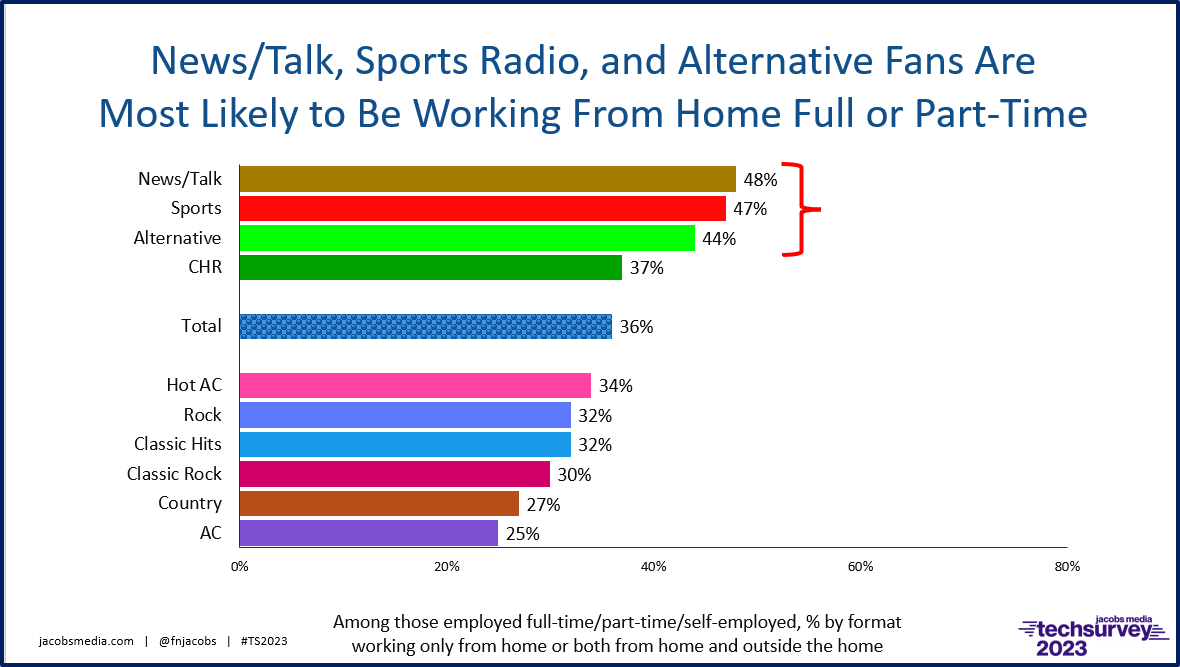
It’s now been more than three years since that fateful month of March in 2020 saw a total shutdown of America and the world.
Today, COVID is no longer a global health emergency, it’s a rarity to see people wearing masks, and menus are rapidly replacing QR codes in restaurants. The pandemic would appear to be over…except it’s not.
While there has been much recovery in our society, one aspect of COVID that has still not returned to normal is the workforce. Why? Because radio listening is rooted in familiar and safe routines. Our “Why radio?” question series reveals many of us are, of course, creatures of habit. Or at least we were.
Pre-pandemic, at least, we did our daily business in pretty much the same way, day in and day out, especially if we were employed full-time. We woke up at the same time (most alarm settings were fixed), and went through our daytime preparations and first interactions with other people in a rote way. And then the morning commute dance, something that millions of us experienced every single workday. And a similar routine played out at work, and on our way back home through snarling traffic.
Until we didn’t. Once COVID rocked our world, everything reset to “zero.” And 39 months later, that return to “normal” still has not happened. Now, many large companies are looking at Labor Day this year as the “great reset.” That’s when many will require their employees to actually show up at their place of work three days a week. That means 60% of the time, still a far cry from how most of us were living our lives in 2019.
Radio programmers depended on that routine – to build music rotations, architect content and personalities by daypart, create contests and giveaways, schedule traffic and weather reports, and pretty much run their entire strategies from the regularity of their market’s radio listeners.
![]() The daypart names, “morning drive” and “afternoon drive” point to the mass activity of commuting to and from work. And radio shows – for decades – have been built and maintained to reflect that collective behavior.
The daypart names, “morning drive” and “afternoon drive” point to the mass activity of commuting to and from work. And radio shows – for decades – have been built and maintained to reflect that collective behavior.
Ironically, A.I. is also built on predictable actions. But unlike radio PDs who track audiences, it focuses right down to the individual. It knows when you leave for work (if you’re not WFH), where you stop for coffee, and where you end up working. It learns your go-out-to-lunch haunts, your workout gym, and your favorite dinner spots.
And you can watch AI go very wrong when multiple people use your account. Netflix and Amazon’s algorithms rapidly become undependable when various family members share a password to buy stuff online or watch TV shows. That’s when those recommendations go awry and remind you that Artificial Intelligence is relative. As we learned long ago, “garbage in, garbage out.”
watch TV shows. That’s when those recommendations go awry and remind you that Artificial Intelligence is relative. As we learned long ago, “garbage in, garbage out.”
At Jacobs Media, we have been following this story since the onset of the shutdown in early 2020. That year, we conducted nine studies across our three radio platforms (commercial, public, Christian music), in addition to our regularly scheduled Techsurveys. Sadly, COVID didn’t “go away” that year, lingering much longer, and disrupting what were once fundamental lifestyle routines.
If you religiously track the ratings for your market or region, you’ve seen and – perhaps – felt the impact. We continue to hear about it in the now hundreds of Zoom focus and LAB groups, as well as one-on-one interviews we’ve conducted since COVID’s onset.
Things still aren’t “normal,” especially as it relates to the job market, the workplace, and that well-publicized work/life balance.
Techsurvey sheds some light on this. Overall, 12% of our radio-centric sample say they’re listening to less broadcast radio since the year before. And tied for first (with “lifestyle change”) is “I’m spending less time in a car.” That goes right to the core of the problem. But as the year-to-year trend shows, it is a drag on radio listening that has been abating the past two years.

Still, 40% of those spending less time in radio point to reduced time behind the wheel. That’s still a higher level than what we’d normally see in a non-COVID year. (Keep in mind Techsurvey 2020 was fielded in January/February of that year – pre-COVID.)
So, for the first time every in our 19 Techsurveys, this year we included questions about jobs and the workplace. And the first thing we learned is that similar to what the Bureau of Labor Statistics has been reporting for some time now, only a tiny 3% of American adults are unemployed. Now, our survey is among core radio listeners – by definition older than the population. As a result, nearly one in four describes their work status as “retired.”

The pie chart on the right is especially revealing, zeroing in on where those who are employed are actually working. And while nearly two-thirds say they exclusively work outside the home, many are still in various stages of working from home. As of January and February (our fielding period), 16% were exclusively WFH, while one-fifth were engaged in a hybrid work/home situation. When you’re talking radio listening, those are big numbers to no longer be regularly commuting to and from work in what used to be “drive times.”
But it gets more interesting. We broke out the WFHers by format, and came up with this fascinating pecking order:
Of course, your station’s “mileage may vary.” But significantly, those loyal to News/Talk, Sports Radio, and Alternative are quite a bit less likely to be spending time in a cubicle or in a workspace away from home. And even looking at the formats near the bottom of the chart, at least one-fourth of their employed listeners are spending all or part of their working hours in the home office – or maybe the couch.

And despite the hopes of companies and corporations, WFH isn’t likely to go away this fall. Talk to most Millennials and they’ll tell you its about salary, benefits, and workplace flexibility – not necessarily in that order. The pictured ad in the Wall Street Journal speaks volumes about the lingering mindset in the workplace.
None of this suggests programmers need to scrap their content schemes. But the data strongly shows the old patterns have likely been warped by COVID. If your station participated in Techsurvey 2023, a look at your station’s WFH listening levels will provide an indication of how your audience is shifting. Everyone else can ask these (and other) questions in perceptual research studies or even in music tests to get a better sense of how work patterns inform changing listening habits.
Whether you’re a commercial radio PD slotting in contest giveaways or a public radio programmer scheduling shows, gaining a better understanding of your audience’s work patterns better inform your tactics.
inform your tactics.
As Techsurvey 2023 data shows, time spent in cars has normalized – a lot. But it has still not returned to pre-pandemic status. Are your employed listeners using radio differently at home than they traditionally do in an office setting? Are their expectations different, and how can you better meet their needs?
In radio programming, we often take things for granted – the commute, listening at work, radio usage in cars, and other former “givens.” Asking the right questions about how work and employment trends impact listening is all part of keeping up with the changes of the 2020s.
One last thing: you may have seen the recent May jobs reported 80,000 layoff announcements in the U.S. But the story within the story was that 3,900 of those cuts were due to A.I. replacing workers.
workers.
You can bet economy watchers will have an eye on this stat for the next many months – or years.
In tomorrow’s post, I’ll take a look at ways to make sure you’re not one of them.
- What To Do If Your Radio Station Goes Through A Midlife Crisis - April 25, 2025
- A 2020 Lesson?It Could All Be Gone In A Flash - April 24, 2025
- How AI Can Give Radio Personalities More…PERSONALITY - April 23, 2025




Two quick observations:
1) I see the driving less stats differently than you do. It’s been compounding since 2020, so a comparison to 2019 driving levels would be instructive than a year to year change in percentage. Each of the decreases was based on a significantly lower number, so while the rate of decline has slowed, overall driving has dropped a lot since 2019. Kinda like compound interest on money.
2) Radio’s stuck in the car calculus will have to change. It’s still unclear where all of this will level off, the 5 day/week commute will never be a given the way it has been since they started putting radios in cars. So the idea of drive time will be a lot squishier than it ever was and radio will have to just be entertaining to thrive as its audience gets progressively less captive to twice/day commutes.
I understand your point – that each year’s percentage is relative to a decreasing total. And you’re right. It’s worse that it looks.
I think we’re going to learn a lot this fall when many big companies are going to (try to) lay down the gauntlet with their rank-and-file to at least get them to show up 3x a week. By the December holidays, we’ll know a lot. (I’m not holding my breath.)
I agree with that the “car calculus” needs to change. There is very little HD radio home equipment being sold given that one selling point for radio is the fact there is no subscription fee.
Would people give up their subscriptions (i.e., Sirrius/XM) if there were choices available elsewhere?
Maybe NOT the response you want. . .I appreciate your viewpoint, but I have a different perspective on the matter of QR codes. It is evident that their usage has significantly increased and shows no signs of diminishing. While it’s possible that in smaller towns where a waitress still walks safely to work, traditional methods may prevail, it’s important to recognize that QR codes have found widespread application, even in healthcare facilities. #embracethecode 💃
I’m a fan of those squiggly codes, Lu. And they’re the right price!